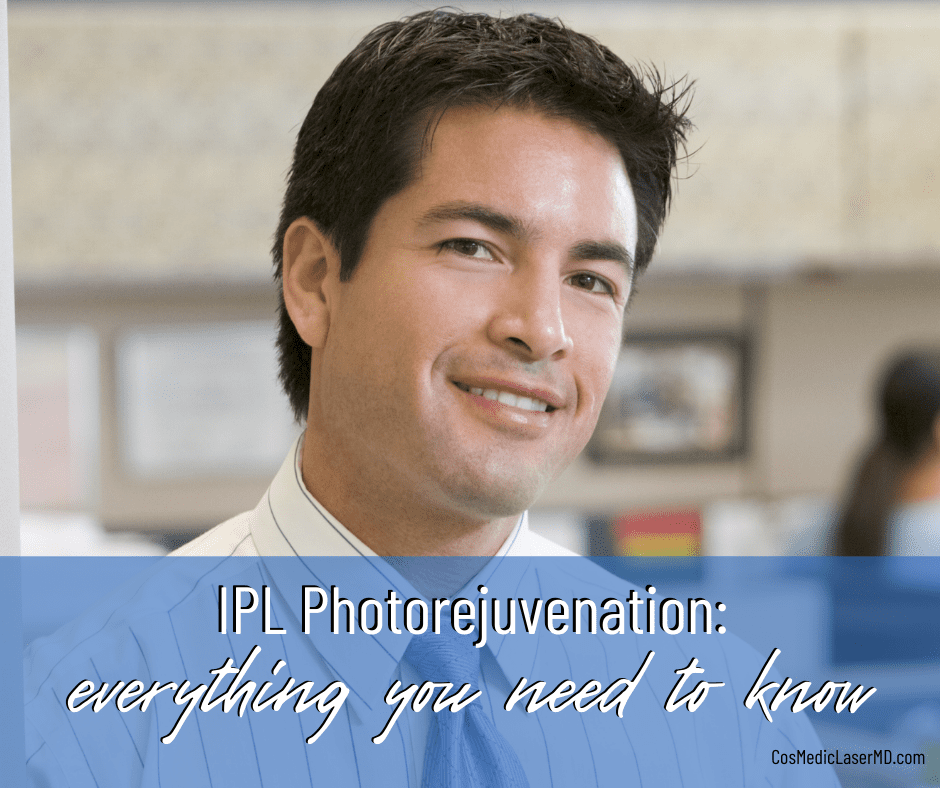
Photorejuvenation is an ideal treatment for blotchy redness, brown spots and even broken blood vessels on the face – but is it the right procedure for you? This guide explains photorejuvenation, how it works and what it treats, as well as what you can expect from the procedure.
Photorejuvenation: Kiss Spots and Blotches Goodbye
For some people, IPL photorejuvenation is the perfect solution to all kinds of skin discoloration. Using an intense pulse light (that’s where the “IPL” comes in), your doctor can treat a wide range of skin concerns and conditions, including brown patches, blotchy red spots and even broken blood vessels that you can see under the surface of your facial skin. The results are quick, and there’s very little (or no) downtime involved with the procedure.
What is IPL Photorejuvenation?
Sometimes called a photofacial, IPL photorejuvenation stimulates collagen production in your skin. As a result, your skin texture improves, pores appear smaller, and fine lines become less noticeable. Your entire appointment will last between 20 and 30 minutes.
Does Photorejuvenation Hurt?
IPL photorejuvenation doesn’t hurt. You don’t need anesthetic cream to minimize discomfort, unlike some other facial procedures, because treatment with an intense pulse light doesn’t hurt. You shouldn’t be in any discomfort after the procedure, either. However, you may experience slight swelling under your eyes – and you should avoid sun exposure before and after your procedure to protect your skin.
How Many Treatments Do You Need?
Generally, people need four or five treatments with an IPL. Each treatment is spaced three to four weeks apart. However, you’re likely to see improvement after just one treatment. Your doctor will most likely recommend that you “treat to complete” even if you notice significant results after one or two treatments, though; that’s because you have the potential to see even better results – and to have the skin you’ve always wanted.
Related: How to remove hand wrinkles
How Long Do Photorejuvenation Results Last?
When you’ve completed the full series of treatment, provided that you take good care of your skin and protect it from the sun, your skin will continue to look its best. You may choose to opt for annual maintenance treatments to keep promoting collagen production in your skin, which is part of what makes IPL photorejuvenation so effective as a treatment.
You should talk to your doctor about the right skincare regimen for you. Your doctor can tell you what to do to care for your skin based on your skin type, your age and several other factors – including how much time you spend in the sun – so that you can make the right choices to protect yourself and prevent signs of premature aging.
Related: Does dermaplaning rejuvenate your skin?
How Do You Care for Your Skin After Photorejuvenation?
You should avoid exposure to the sun and wear sunscreen when you have to be outdoors. That way, you’ll protect your skin from ultraviolet rays and the damage they cause. If you don’t protect your skin, brown spots and blotchy redness can reappear more quickly than they would if you took the appropriate safety measures.
Is Photorejuvenation Better Than a Chemical Peel?
Photorejuvenation is different from a chemical peel, though both can be used to treat things like blotchy spots and fine lines. Photorejuvenation makes light penetrate your skin to boost collagen production, while a chemical peel removes the outermost layers of your skin. You should talk to your doctor about which procedure is right for you – or if there’s another procedure that would be a better fit (such as platelet-rich plasma, dermaplaning or laser resurfacing) to help you reach your goals.
Ready to Talk About IPL Photorejuvenation in Ann Arbor?
Our Ann Arbor med spa can help you get the look you want, from clear and youthful skin to fat reduction. Call or text us at 734-249-8722 or fill out the form below to get in touch.


